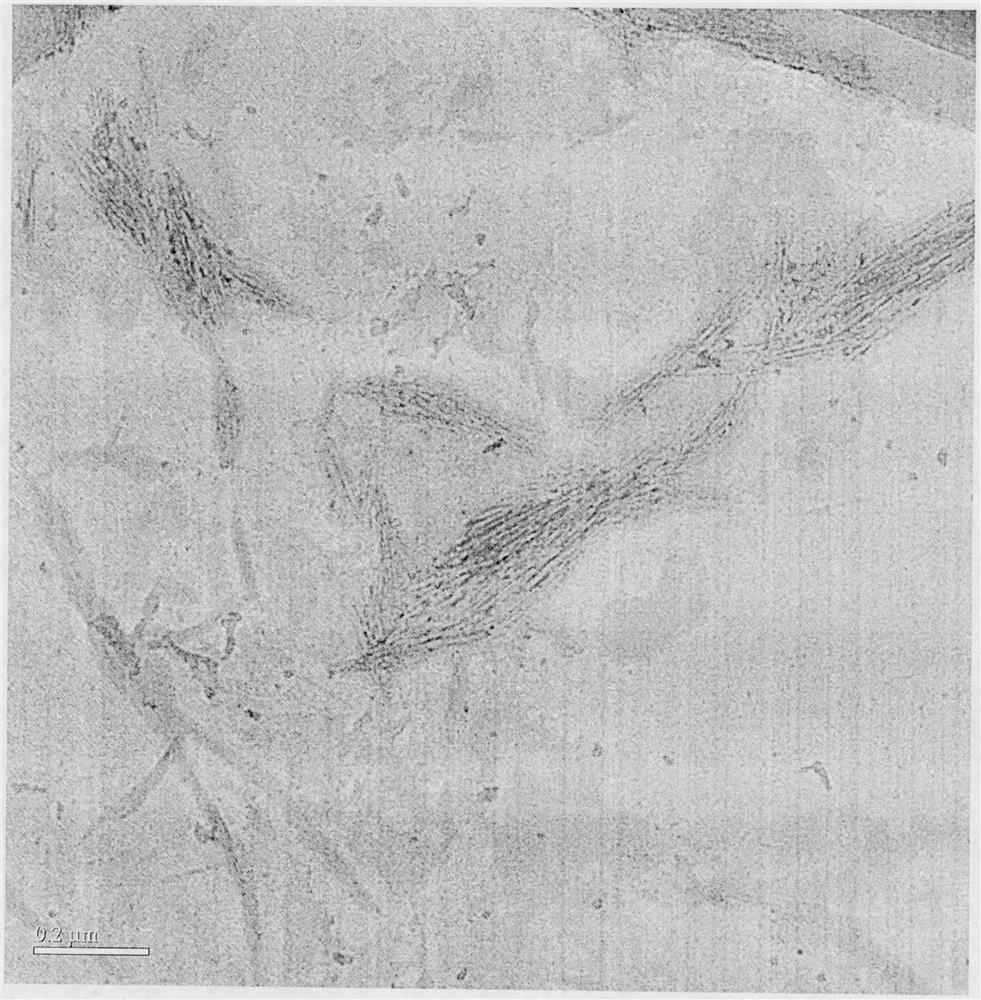Method for preparing cellulose nanocrystals by hydrolyzing cellulose with eutectic solvent
A technology of deep eutectic solvent and nanocrystals, which is applied in the field of preparation of natural polymer materials, can solve the problems of low product thermal stability, low yield, cumbersome overall steps, etc., to achieve increased yield, lower reaction temperature, simplified The effect of the preparation process
- Summary
- Abstract
- Description
- Claims
- Application Information
AI Technical Summary
Problems solved by technology
Method used
Image
Examples
Embodiment 1
[0020] Add 40g of citric acid and 45g of betaine into a 250mL three-necked flask at 25°C, and add 5g of distilled water into it, then heat it with an oil bath, raise the temperature to 50°C, stir mechanically for 10min, and the stirring speed is 100r / min , form a deep eutectic solvent, then add 5g of sulfuric acid with a mass concentration of 98% into the there-necked flask, stir for 5min, then add 1g of bleached eucalyptus pulp, continue to stir at 55°C for 5h, and react with 300g of 90°C distilled water Dilute the mixture, then centrifuge at 10,000r / min for 5min while it is hot, pour out the supernatant and keep the precipitate, then disperse the obtained precipitate with 100g of distilled water, centrifuge at 10,000r / min for 5min, and repeat the process. Centrifugal washing with distilled water was performed three times, and the solid obtained after washing was freeze-dried, and the yield of cellulose nanocrystals was 74.5%. The temperature at which the resulting product lo...
Embodiment 2
[0022] Add 40g of citric acid and 50g of betaine into a 250mL three-neck flask at 25°C, add 5g of distilled water into it, then heat it with an oil bath, raise the temperature to 55°C, stir mechanically for 10min, and the stirring speed is 300r / min, Form a deep eutectic solvent, then add 10 g of sulfuric acid with a mass concentration of 98% in the there-necked flask, stir for 5 min, then add 10 g of dissolving slurry, continue stirring at 55 ° C for 4 h, and dilute the reaction mixture with 700 g of 60 ° C distilled water, Then centrifuge at a speed of 10000r / min for 8min while it is hot, pour out the supernatant and keep the precipitate, then disperse the obtained precipitate with 800 g of distilled water, then centrifuge at a speed of 10000r / min for 8min, repeat this centrifugation with distilled water The washing process was performed 5 times, and the solid obtained after washing was freeze-dried, and the yield of the obtained nanocellulose crystal was 78.0%. The temperatu...
Embodiment 3
[0024] Add 40g of citric acid and 40g of betaine into a 250mL three-neck flask at 30°C, add 10g of distilled water to it, then heat it in an oil bath, raise the temperature to 60°C, stir mechanically for 10min, and the stirring speed is 200r / min, Form a deep eutectic solvent, then add 10 g of sulfuric acid with a mass concentration of 98% to the there-necked flask, stir for 5 min, then add 3 g of cotton pulp, continue stirring at 60 ° C for 2.5 h, and dilute the reaction mixture with 300 g of 65 ° C distilled water , then centrifuge at 8000r / min for 5min while hot, pour out the supernatant and keep the precipitate, then disperse the obtained precipitate with 600g of distilled water, then centrifuge at 8000r / min for 5min, repeat this centrifugation with distilled water The washing process was performed 5 times, and the solid obtained after washing was spray-dried, and the yield of the obtained nanocellulose crystal was 81.5%. The temperature at which the resulting product loses...
PUM
 Login to View More
Login to View More Abstract
Description
Claims
Application Information
 Login to View More
Login to View More - R&D
- Intellectual Property
- Life Sciences
- Materials
- Tech Scout
- Unparalleled Data Quality
- Higher Quality Content
- 60% Fewer Hallucinations
Browse by: Latest US Patents, China's latest patents, Technical Efficacy Thesaurus, Application Domain, Technology Topic, Popular Technical Reports.
© 2025 PatSnap. All rights reserved.Legal|Privacy policy|Modern Slavery Act Transparency Statement|Sitemap|About US| Contact US: help@patsnap.com

